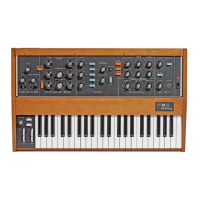A GUIDE TO THE OPERATION OF THE MINI MOOG
MODEL D
A. INTRODUCTION
An electronic music synthesizer is a musical instrument whose
circuitry can be interconnected and set up in a large variety of
ways to produce a broad spectrum of musical sounds. The component
circuit controls and interconnections of the Mini Moog Synthesizer
are arranged in a logical and convenient way which is ideal for
live performance.
The purpose of this manual is to acquaint you with the component cir-
cuitry of the Mini Moog and the operation of each of the controls
and switches regulating the generators, modifiers, and control devices
involved in the synthesizing of a musical sound. After proceeding
step by step through the instructions outlined below, you should be
ready to begin using your instrument creatively and efficiently.
B. BASIC MINI MOOG FEATURES
The Mini Moog contains the basic components and features to be
found on larger, studio-oriented synthesizers. Its five sound sources
include three oscillators for the production of pitched tones, one
noise source for the production of unpitched sounds, and one microphone
preamplifier for the introduction of live signals. Mixer controls are
available for balancing these signals.
Sound modifiers include a lowpass filter and an amplifier, both of
which have their own contour generators. The control devices include
a 44-note keyboard for use by the right hand, and two wheel controls
and two switches for use by the left hand.
Provision is made at the rear of the instrument for connecting
external controlling devices such as sequencers, foot pedals, and two-
dimensional (joystick) controllers. These may be used to control volume,
pitch, and filter characteristic. Timing signals may also be introduce
to trigger the contour generators.
C. AUDIO, CONTROL, AND TIMING SIGNALS
Sound travels through the Mini Moog circuitry in the form of
electrical signals which are called AUDIO signals. These audio signals
are generated by the five sound sources, and after undergoing extensive
modification emerge as the output signal. It is this signal, amplified,
which is translated into sound by your speaker system.
1

